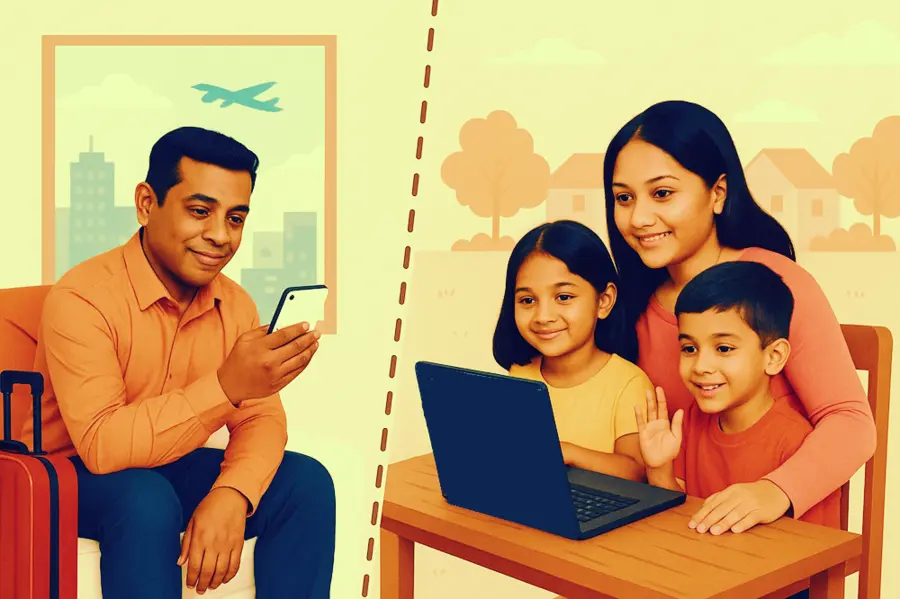Global Bonds at a Distance: The Impact of Transnational Families on Socialization and Child Development
Transnational families navigate cross‑border caregiving through remittances and digital communication, reshaping children’s socialization and development.
Extended kin and community networks buffer separation, while policies and ICT access influence emotional wellbeing, education, and identity formation.
Balancing material support with quality interactions fosters resilience, bicultural competence, and family bonds, nurturing positive outcomes.
Let’s explore how transnational family arrangements shape socialization processes.

Transnational Families and Their Impact on Socialization: Introduction
Transnational families—households in which members live across national borders—have become increasingly prevalent in our globalized world.
Fueled by economic necessity, educational aspirations, and political instability, these family configurations challenge traditional notions of household and socialization.
Transnational families reshape socialization by blending cultures, values, and communication across borders.
Children often develop hybrid identities, negotiating traditions from both home and host countries, shaping unique worldviews and connections.
As of 2023, global remittance flows reached an estimated USD 857 billion, underscoring the financial ties that bind families across distances.
Global remittance flows reached USD 905 billion in 2024, up 4.6% year‑on‑year, with digital transfers comprising significant share, bolstering global economic resilience.
Remittance flows to low‑ and middle‑income countries are projected at USD 690 billion in 2025, growing 2.8%, driven by migration, income disparities.
Defining Transnational Families
A transnational family typically involves at least one parent or guardian who migrates for work, education, or safety, leaving children or partners “left behind,” while maintaining frequent communication and economic support.
Unlike past migration patterns characterized by permanent relocation, today’s migrants often circulate between origin and destination, enabled by cheaper travel and digital connectivity.
This fluidity has given rise to new family practices of care, identity formation, and socialization, mediated both by remittances and virtual co-presence.
Transnational Families: Global Scope and Trends
Transnational families are a hallmark of today’s interconnected world, with several key trends shaping their composition and experiences.
Rising Remittance Flows
In 2023, migrants sent home an estimated USD 857 billion, making remittances one of the largest financial inflows to low‑ and middle‑income countries. These funds often cover school fees, healthcare, and daily expenses, bolstering household resilience. However, overreliance can foster financial dependency, distort local labor markets, and leave families vulnerable to global economic shocks.
Gendered Migration Patterns
Approximately half of all international migrants are women, many employed as domestic or care workers abroad. Their absence shifts caregiving duties onto grandparents, older siblings, or hired help, altering intergenerational dynamics. Women migrants often remit a higher proportion of earnings, yet face heightened emotional strain from separation and social stigma related to non‑traditional gender roles.
Growth in Family‑Reunification Visas
OECD countries issued around 2.5 million family‑reunification visas in 2023—an 18% increase over 2022—in response to post‑pandemic migration pressures. These visas facilitate spouses’ and children’s entry, reducing prolonged separation. Yet lengthy processing times, high application fees, and stringent eligibility criteria continue to delay reunification, especially for lower‑income migrants.
Climate‑Induced Displacement
Extreme weather events—droughts, floods, hurricanes—force rural and coastal household members to migrate temporarily for income, while others remain to safeguard property and livelihoods. This split pattern disrupts traditional farming practices and community cohesion. Remittances from climate migrants fund local adaptation projects, but chronic environmental risks can create cyclical migration and deepen socioeconomic inequalities.
Education‑Driven “Parachute” Migration
Families in East Asia and the Middle East increasingly send children abroad for secondary or tertiary education, often residing with host‑family arrangements or boarding schools. Parents stay in the origin country to manage expenses and careers. These “parachute” students gain language skills and global exposure, yet may experience loneliness, cultural dislocation, and pressure to succeed academically.
Digital Co‑Presence Intensification
Advancements in affordable smartphones and high‑speed internet have enabled migrants to maintain daily routines—homework help, bedtime stories, and mealtime chats—via video calls and messaging apps. Quality of interaction, rather than frequency, predicts stronger emotional bonds. Still, time‑zone differences, connectivity issues, and parents’ irregular work hours can lead to fragmented communication and feelings of neglect.
Circular and Multi‑Sited Living
Rather than permanent relocation, many migrants adopt circular migration—commuting seasonally or annually between origin and destination. This pattern preserves ties to land, kin, and community rituals. Regular return visits reinforce social roles and facilitate direct caregiving. However, travel costs and visa restrictions can disrupt planned cycles, forcing prolonged absences and heightened uncertainty.
Diversification of Care Networks
With parents abroad, households increasingly rely on extended kin—grandparents, aunts, uncles—or paid caregivers and community childcare services. This diversification offers resilience when a primary caregiver relocates, yet raises concerns about consistency in caregiving quality and potential exploitation in informal care arrangements. Training and support for substitute caregivers remain limited in many regions.
Policy and Regulatory Shifts
Migration policies fluctuate with political and economic climates, affecting family unification and labor mobility. Bilateral labor agreements can streamline low‑skill worker migration, but often exclude dependents. Travel bans and stricter visa quotas prolong separations. Conversely, some countries are experimenting with humanitarian corridors and simplified family‑visa pathways to address demographic declines and labor shortages.
The sheer scale of these movements underscores the urgency to understand their social and developmental ramifications.
Mechanisms of Socialization in Transnational Contexts
Socialization—the process by which individuals internalize societal norms, values, and behaviors—occurs through multiple channels in transnational families:
Economic Provision via Remittances
Migrant parents regularly send financial support to their families through remittances, enabling children to access better nutrition, healthcare, and education opportunities. This material provision shapes socialization by influencing children’s aspirations, peer interactions, and participation in community activities. However, reliance on remittances can also create dependency and unrealistic expectations regarding future financial support, potentially affecting children’s autonomy and long‑term life choices.
Digital Co‑Presence via ICT
Affordable smartphones, high‑speed internet, and messaging apps allow migrant parents to maintain daily interactions with their children through video calls, voice messages, and shared digital activities. These virtual exchanges foster emotional bonds, facilitate routine management like homework assistance and bedtime stories, and reinforce parental authority. Yet time‑zone differences, connectivity issues, and irregular work hours can interrupt communication, leading to feelings of neglect.
Extended Family and Community Networks
When parents migrate, caregiving shifts to grandparents, aunts, uncles, or older siblings who provide supervision, cultural guidance, and emotional support. Community institutions like schools and religious organizations also contribute to socialization through mentorship and peer interaction opportunities. Reliance on these networks varies by cultural norms and resource availability, influencing the consistency and quality of caregiving experienced by children in transnational family settings.
Cultural Remittances and Media Flows
Migrants transmit cultural practices, values, and media consumption habits back to origin communities through social media, streaming services, and digital content. These remittances shape children’s identities by exposing them to new languages, norms, and worldviews, while preserving traditions via online storytelling and rituals. The interplay of global and local influences fosters hybrid cultural identities in both sending and receiving contexts.
Return Visits and Transnational Events
Periodic journeys back to the origin country for holidays, religious festivals, or family ceremonies allow migrant parents and children to engage in shared cultural rituals and reintegrate social roles. These in‑person interactions reinforce familial bonds, transmit intergenerational knowledge, and provide context for identity formation. However, travel costs, visa restrictions, and temporal pressure can limit the frequency and depth of these reunions.
The Impact of Transnational Families on Child Wellbeing and Development
Recent empirical research offers nuanced insights into how transnational arrangements affect child outcomes:
Attachment Security
Children in transnational families may develop secure attachments when extended caregivers maintain consistent support, yet prolonged parental absence can lead to anxiety and clinginess. Regular, high‑quality virtual contact can mitigate insecurity, but sporadic interactions risk reinforcing fears of abandonment. Overall, attachment outcomes hinge on the reliability of substitute caregivers and the depth of parent‑child communication routines established across distances.
Emotional Wellbeing
Separation from migrant parents often triggers feelings of loneliness, sadness, and anger in children, particularly when communication is infrequent or disrupted by time‑zone differences. Conversely, reliable remittances can reduce financial stress and enhance life satisfaction. Emotional resilience depends on community and extended‑family support, with counseling or peer‑support groups proving beneficial for children struggling with parental absence and identity confusion.
Academic Achievement
Remittance‑funded educational resources—tutoring, school fees, and technology—can bolster academic performance. However, the absence of parental supervision may diminish study motivation and discipline, leading to inconsistent homework routines. Children with strong extended‑family or mentor involvement often fare better, while those in dual‑migrant households face higher risks of literacy gaps and decreased school engagement, underscoring the need for balanced material and emotional support.
Behavioral Development
Children left behind may exhibit both positive autonomy—handling chores and decision‑making—and problematic behaviors like defiance or risk‑taking, depending on caregiving quality. Those with well‑trained substitute caregivers often develop responsibility and self‑reliance, whereas inconsistent discipline and emotional distress heighten impulsivity and conduct issues. Effective behavioral outcomes arise from structured routines, clear expectations, and regular communication with migrant parents.
Social Competence
Transnational children interact closely with peers and non‑parental adults, fostering adaptability, negotiation skills, and cross‑cultural awareness. Yet, feelings of otherness or stigma can impair peer relationships, especially if classmates lack understanding of migration contexts. Participation in community and school activities, supported by both local mentors and migrant parents via ICT, enhances empathy, teamwork, and conflict‑resolution abilities.
Identity Formation and Cultural Transmission
Navigating dual cultural expectations, transnational children often craft hybrid identities, integrating heritage values with host‑country norms. Transnational families negotiate multiple identities, including:
Ethnic and Religious Identity
Children in transnational families often inherit rich, hybrid belief systems when parents transmit religious customs across borders. Through video‑call storytelling, ritual demonstrations, and faith‑based gifts, youth internalize hometown traditions while absorbing host‑country norms. This blending cultivates a multifaceted identity, enabling children to navigate diverse social settings with confidence. By participating in transnational rituals, they reinforce familial bonds, sustain communal heritage, and develop a nuanced sense of spirituality. Autoethnographic work on Muslim transnational families shows children adopt hybrid religious practices through family talks, negotiating between home‑country rituals and host‑country norms.
Bicultural Socialization
In families balancing heritage and host‑culture expectations, parents who emphasize bicultural values foster children’s autonomy and resilience. For instance, Chinese American parents who encourage both ancestral customs and mainstream practices help youth develop adaptive coping strategies. This dual orientation enhances self‑esteem, social competence, and academic motivation. However, when cultural demands conflict, children may experience acculturative stress, underscoring the importance of open dialogue and consistent parental support in nurturing healthy bicultural identities.
“Parachute Generation”
“Parachute kids”—students sent abroad for schooling while parents remain overseas—experience accelerated independence and cross‑cultural learning. Living with host families or in boarding settings, they assume self‑management of daily tasks and academic responsibilities, often maturing rapidly. Yet, despite frequent video contact, they can feel emotional distance and heightened pressure to succeed. Intergenerational tensions may arise when children question the necessity of parental absence, highlighting the complex trade‑offs inherent in educational migration. Ethnographic interviews with Chinese “parachute kids” studying abroad—while parents remain in China—reveal accelerated maturity yet also intergenerational tensions, as children question the necessity of such separation despite frequent communication.
Digital Cultural Remittances
Through platforms like YouTube, streaming services, and social media, migrant parents share films, music, and online cooking sessions that impart homeland cultural norms and aesthetics. Children engage in joint viewing parties or virtual festivals, deepening emotional ties and fostering shared cultural capital. This digital flow not only preserves traditions but also enables youth to curate unique cultural repertoires, blending global influences with familial heritage across geographic distances.
Language Transmission
In transnational households, parents and caretakers prioritize native language use during video calls, bedtime stories, and cultural celebrations to ensure linguistic continuity. Children learn heritage vocabulary, idioms, and proverbs, which bolsters cultural pride and cognitive flexibility. Bilingual proficiency enhances academic performance and cross‑cultural communication skills. Maintaining language practices across generations fosters intergenerational solidarity and empowers youth to navigate both origin‑country contexts and globalized environments with linguistic confidence.
These dynamics illustrate how transnational contexts can both enrich and complicate cultural socialization.
Role of Communication Technologies
Digital tools transform long‑distance parenting:
- Frequency vs. Quality: Regular contact via video or chat helps maintain routines and emotional bonds, but quality—depth of conversations, shared activities—matters more than call count.
- Platform Choice: Video conferencing platforms enable visual cues and shared screen activities (e.g., reading stories together), while messaging apps offer asynchronous support.
- Challenges: Connectivity issues, time‑zone differences, and parents’ work schedules can disrupt communication, leading to feelings of neglect.
Overall, ICTs play a dual role: mitigating distance but also highlighting its constraints, demanding intentional communication strategies to support healthy socialization.
Bridging Distance: Policy Recommendations for Transnational Family Socialization
Transnational families face unique socialization challenges due to separation, technological barriers, and varied caregiving arrangements. The following policy interventions and practitioner strategies can strengthen emotional bonds, ensure consistent caregiving, and support children’s wellbeing across borders.
Reunification‑Friendly Policies: Simplify and expedite family‑visa applications, waive or reduce application fees, and offer subsidized travel vouchers. Faster, affordable reunification minimizes prolonged separations, preserves parental bonds, and alleviates emotional strain—especially for low‑income migrants whose children benefit from regular, in‑person interactions and cultural continuity.
Digital Access Initiatives: Partner with telecom providers and NGOs to subsidize broadband and data plans in origin communities. Stable, low‑cost internet ensures reliable video calls, educational support, and virtual cultural activities. Improved connectivity fosters high‑quality digital co‑presence, mitigates the isolating effects of distance, and enhances parent–child communication.
Caregiver Support Programs: Develop training modules and resource toolkits for extended‑family and community caregivers. Offer workshops on child development, attachment, trauma‑informed care, and mental‑health first aid. Equipping substitute caregivers with best practices ensures consistent nurturing environments, reduces emotional risk for left‑behind children, and upholds developmental standards.
School‑Based Interventions: Establish counseling services, peer‑support clubs, and mentorship schemes within schools hosting left‑behind and “parachute” students. Trained counselors can address separation anxiety, cultural adjustment, and identity issues, while peer networks foster belonging. These interventions promote resilience, academic engagement, and healthy social skills in transnational contexts.
Remittance Efficiency: Advocate for regulatory measures and fintech solutions that lower average remittance fees (currently ~ 6.4 %). Reducing transaction costs increases the net funds available for education, extracurricular activities, and community engagement. Enhanced financial flows empower families to invest in socialization‑promoting resources and long‑term wellbeing.
Such measures can strengthen the protective factors within transnational family systems and mitigate separation‑related risks.
Read Here: The Sociology of Refugee Resettlement and Integration
Conclusion
Transnational families are reshaping the landscape of childhood socialization. While economic provision and digital communication offer new pathways for care, physical separation poses emotional and developmental challenges.
Recent studies underscore the nuanced outcomes: from stable attachment in extended‑kin networks to heightened emotional strain when both parents migrate.
As global migration persists, a coordinated approach—integrating family‑friendly policies, technological access, and caregiver support—will be vital to ensure that children in transnational families develop the social competencies and emotional resilience needed to thrive in an interconnected world.
Read Also: The Impact of Immigration Policies on Migrant Communities
Author: Mahtab Alam Quddusi – A Passionate Writer, Social Activist, Postgraduate in Sociology and Social sciences and Editor of The Scientific World





